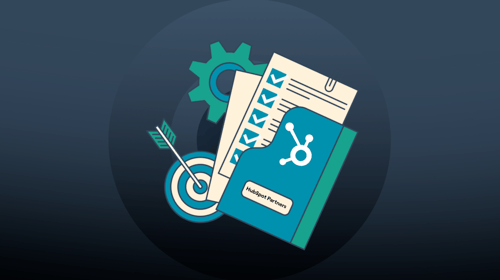In this article, we’ll show you how to build an AI-enhanced MRR pipeline in HubSpot, how to surface actionable insights, align sales and finance across borders, and forecast revenue with confidence in a constantly evolving market.
Monthly Recurring Revenue (MRR) is one of the most reliable metrics to measure predictable revenue growth.
Traditional reporting methods often fall short for businesses operating at scale because they rely heavily on manual processes, lack real-time insights, and struggle to handle the complexity of modern revenue metrics like MRR.
As data volume grows, these outdated systems become error-prone, inefficient, and difficult to scale. That’s why organizations are turning to AI-powered tools like HubSpot Sales Hub, to gain accuracy, automation, and clarity in their revenue tracking.
Transforming MRR tracking with AI-powered insights
MRR offers a clear, consistent view of financial health, helping revenue leaders understand how much income is contractually secured each month across global operations. Organizations rely on MRR to:
- Standardize revenue visibility across regions, departments, and currencies
- Align teams on performance and forecasting goals, regardless of geography
- Identify risks and opportunities proactively, not reactively
With AI now embedded in platforms like HubSpot, MRR tracking evolves from static reporting into a dynamic, intelligence-driven process.
HubSpot’s AI can:
- Detect anomalies and churn risk early
- Forecast recurring revenue trends using historical data and deal behavior
- Recommend actions for renewals, upsells, or customer retention
By embedding MRR into your core analytics, you empower revenue, finance, and operations teams to make faster, data-backed decisions, whether it’s optimizing team performance, scaling in new markets, or planning resourcing.
In short: MRR gives enterprise leaders the financial clarity needed to scale confidently, with the power of AI to stay one step ahead.
How to build a scalable, AI-powered MRR pipeline in HubSpot
Managing recurring revenue at enterprise scale—across global teams, business units, and thousands of deals—demands more than manual tracking or static reports. HubSpot Sales Hub Enterprise offers robust recurring revenue functionality, and as of 2025, its AI-enhanced features take accuracy, forecasting, and visibility to the next level.
Step 1: Capture recurring revenue directly on the deal record
To ensure every opportunity is properly reflected in your revenue pipeline, add the following fields to each deal:
-
Recurring revenue amount (e.g., £8,000 per month)

-
Recurring revenue deal type – such as new business, expansion, or renewal

-
Recurring revenue inactive date – when the recurring revenue is expected to end
-
Recurring inactive reason – e.g., churn, contract expiry, or upgrade
Step 2: Monitor recurring revenue trends in Sales Analytics
Once your deals are structured correctly, head to the Sales Analytics > Revenue section. Here, HubSpot breaks down your monthly recurring revenue (MRR) pipeline into:
-
New recurring revenue entering the pipeline
-
Inactive or churned revenue falling out
-
Net revenue change across periods


This provides your revenue operations team with a live view of how your pipeline is evolving—whether you're expanding, renewing, or losing recurring deals—across any date range or segment (region, business unit, deal type).
-
Operational scalability: Structured data ensures your revenue tracking scales with your business
-
Improved forecasting: Real-time MRR trends support better financial planning and board reporting
-
AI-powered insights: HubSpot’s AI surfaces trends and anomalies across segments
-
Cross-team visibility: Sales, Finance, and RevOps teams stay aligned on performance
By combining structured deal inputs with powerful AI-backed analytics, enterprise organizations can move beyond static revenue snapshots and toward a dynamic, forward-looking view of recurring revenue performance.
Leverage AI for smarter forecasting with Breeze
While HubSpot provides foundational forecasting capabilities, organizations often need more advanced, tailored insights, especially across multiple regions, product lines, or sales teams.HubSpot Breeze enhances your HubSpot MRR data with AI-driven forecasting that can:
- Predict recurring revenue trends based on historical patterns, deal velocity, and customer engagement
- Flag at-risk accounts and stalled deals using machine learning models trained on enterprise sales behavior
- Surface recommendations for upsells, renewals, and churn mitigation, all directly within your HubSpot dashboards
By integrating Breeze, enterprises get forecasting that’s not only automated, but intelligent, turning raw deal data into precise, actionable revenue predictions.
- Segment by region, business unit, or team
It’s essential to view MRR not just in aggregate but broken down by geography, team, or product line. HubSpot’s customizable dashboards and AI-driven filters make it easy to zoom in on the metrics that matter most to each leadership tier. - Automate reporting & alerts
Set up AI-driven alerts for dips in forecasted MRR, stalled renewals, or sudden changes in pipeline momentum. This enables revenue operations teams to take corrective action instantly, rather than waiting for end-of-quarter reports.
With the right setup, HubSpot can be a powerful platform for recurring revenue insight and scale, especially when guided by a deep understanding of how to tailor it to complex needs.
Aligning sales and finance with a single source of revenue truth
One of the biggest challenges for enterprise organizations is aligning Sales and Finance on revenue expectations.
These departments often operate on different systems, timelines, and definitions of success, creating disconnects that delay decisions and impact growth.
By centralizing MRR tracking in HubSpot and enhancing it with AI, companies can finally bridge this gap and build a unified view of revenue performance.
Benefits of aligning sales and finance with AI-powered MRR tracking:
- Consistent data definitions: Everyone works from the same revenue definitions, timelines, and attribution logic.
- Shared dashboards and reports: Sales leaders see pipeline value and MRR impact, while Finance sees booked revenue and upcoming drop-off points, all from the same source.
- Faster forecasting cycles: AI shortens the loop between what’s closing and how it affects future revenue, eliminating manual handovers.
- Strategic collaboration: With shared, real-time data, Sales and Finance can co-own revenue strategy, from territory planning to renewal forecasting.
By bringing Sales and Finance together around a shared, AI-powered revenue model, enterprises can increase forecasting accuracy, reduce friction, and make faster, more confident business decisions.
When and how to implement MRR tracking at scale
Timing is everything when it comes to implementing new processes, especially those that affect revenue visibility. While smaller companies can pivot quickly, large, multi-regional teams need structured change management to adopt and benefit from new systems like MRR tracking.
With AI now embedded in HubSpot, much of the heavy lifting, like identifying missing data, surfacing anomalies, and recommending workflows, is automated, significantly reducing the friction of implementation.
Here’s how to roll it out across an enterprise:
- Align stakeholders across regions and functions
Involve sales, finance, RevOps, and regional leaders early. Standardize MRR definitions and use HubSpot’s customizable properties to reflect shared business logic. - Pilot with a strategic segment
Start with one business unit or region to test and refine your setup. Use AI-generated insights to improve your deal structure and rollout playbook before expanding. - Train teams and automate data hygiene
Use HubSpot’s AI-powered guidance to help teams populate the correct fields. Automation can flag incomplete records or inconsistent MRR attribution, so data quality remains high across all teams. - Monitor performance and optimize
Once live, monitor adoption and performance across teams. Use AI-driven reporting to highlight revenue-impacting trends, identify lagging segments, and refine forecasting models in real time.
Rolling out MRR tracking at scale requires a thoughtful approach tailored to the complexities of enterprise teams, where AI can ease the transition and amplify long-term impact.
Take the complexity out of Enterprise MRR forecasting
For companies managing complex sales cycles, diverse regional teams, and ambitious growth targets, having a unified, intelligent revenue pipeline is key to staying competitive.
At Huble, we help global enterprises unlock the full potential of HubSpot’s Sales Hub. From designing scalable revenue frameworks to embedding AI-driven insights across your teams, we ensure your business can make confident, data-backed decisions — faster.
Whether you're restructuring your revenue operations, expanding into new markets, or simply tired of flying blind with fragmented data, we’re here to help.
Contact us today to see how we can architect and scale your MRR reporting, built for enterprise complexity, and future-proofed for the AI era.











-3.png?width=500&height=320&name=Matt%20-%20imagery%20bank%20(8)-3.png)

